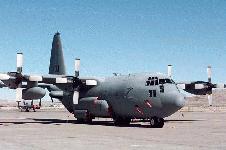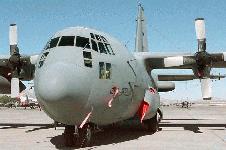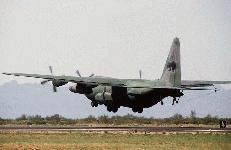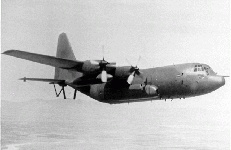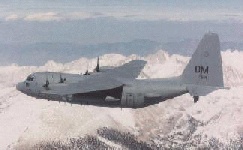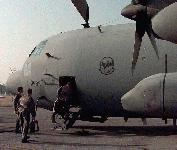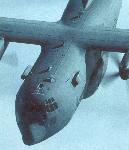
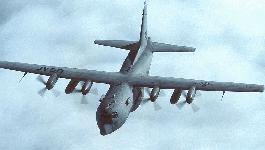
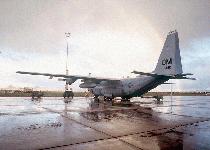



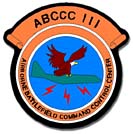 The EC-130E ABCCC consists of seven aircraft that are used as an Airborne Battlefield Command and Control Center. The EC-130E is a modified C-130 "Hercules"; aircraft designed to carry the USC-48 Airborne Battlefield Command and Control Center Capsules (ABCCC III). These one-of-a kind aircraft include the addition of external antennae to accommodate the vast number of radios in the capsule, heat exchanger pods for additional air conditioning, an aerial refueling system and special mounted rails for uploading and downloading the USC-48 capsule. The ABCCC has distinctive air conditioner intakes fore of the engines ("Mickey Mouse ears"), two HF radio probes-towards the tips of both wings, and three mushroom-shaped antennas on the top of the aircraft - and, of course, numerous antennas on the belly.
As an Air Combat Command asset, ABCCC (A-B-Triple-C) is an integral part of the Tactical Air Control System. While functioning as a direct extension of ground-based command and control authorities, the primary mission is providing flexibility in the overall control of tactical air resources. In addition, to maintain positive control of air operations, ABCCC can provide communications to higher headquarters, including national command authorities,
in both peace and wartime environments.
The USC-48 ABCCC III capsule, which fits into the aircraft cargo compartment, measures 40 feet long, weighs approximately 20,000 pounds and costs $9 million each. The ABCCC provides unified and theater commanders an Airborne Battlefield Command and Control Center (ABCCC), with the capability for combat operations during war, contingencies, exercises, and special classified missions. A highly trained force of mission ready crew members and specially equipped EC-130E aircraft to support worldwide combat operations. Mission roles include airborne extensions of the Air Operations Center (AOC) and Airborne Air Support Operations Center (ASOC) for command and control of Offensive Air Support (OAS) operations; and airborne on-scene command for special operations such as airdrops or evacuations.
The ABCCC system is a high-tech automated airborne command and control facility featuring computer generated color displays, digitally controlled communications, and rapid data retrieval. The platform's 23 fully securable radios, secure teletype, and 15 automatic fully computerized consoles, allow the battlestaff to quickly analyze current combat situations and direct offensive air support towards fast-developing targets. ABCCC, is equipped with its most recent upgrade the Joint Tactical Information Distribution System,
allows real-time accountability of airborne tracks to capsule displays through data links with AWACS E-3 "Sentry" aircraft.
The EC-130E ABCCC consists of seven aircraft that are used as an Airborne Battlefield Command and Control Center. The EC-130E is a modified C-130 "Hercules"; aircraft designed to carry the USC-48 Airborne Battlefield Command and Control Center Capsules (ABCCC III). These one-of-a kind aircraft include the addition of external antennae to accommodate the vast number of radios in the capsule, heat exchanger pods for additional air conditioning, an aerial refueling system and special mounted rails for uploading and downloading the USC-48 capsule. The ABCCC has distinctive air conditioner intakes fore of the engines ("Mickey Mouse ears"), two HF radio probes-towards the tips of both wings, and three mushroom-shaped antennas on the top of the aircraft - and, of course, numerous antennas on the belly.
As an Air Combat Command asset, ABCCC (A-B-Triple-C) is an integral part of the Tactical Air Control System. While functioning as a direct extension of ground-based command and control authorities, the primary mission is providing flexibility in the overall control of tactical air resources. In addition, to maintain positive control of air operations, ABCCC can provide communications to higher headquarters, including national command authorities,
in both peace and wartime environments.
The USC-48 ABCCC III capsule, which fits into the aircraft cargo compartment, measures 40 feet long, weighs approximately 20,000 pounds and costs $9 million each. The ABCCC provides unified and theater commanders an Airborne Battlefield Command and Control Center (ABCCC), with the capability for combat operations during war, contingencies, exercises, and special classified missions. A highly trained force of mission ready crew members and specially equipped EC-130E aircraft to support worldwide combat operations. Mission roles include airborne extensions of the Air Operations Center (AOC) and Airborne Air Support Operations Center (ASOC) for command and control of Offensive Air Support (OAS) operations; and airborne on-scene command for special operations such as airdrops or evacuations.
The ABCCC system is a high-tech automated airborne command and control facility featuring computer generated color displays, digitally controlled communications, and rapid data retrieval. The platform's 23 fully securable radios, secure teletype, and 15 automatic fully computerized consoles, allow the battlestaff to quickly analyze current combat situations and direct offensive air support towards fast-developing targets. ABCCC, is equipped with its most recent upgrade the Joint Tactical Information Distribution System,
allows real-time accountability of airborne tracks to capsule displays through data links with AWACS E-3 "Sentry" aircraft.



With the capability to control the electronic spectrum of radio, television, and military communication bands in a focused area, the Commando Solo aircraft can prepare the battlefield through psychological operations and civil affairs broadcasts. These modified C-130Es provide broadcasting capabilities primarily for psychological operations missions; support disaster relief operations; and perform communications jamming in military spectrum and intelligence gathering. One oversized blade antenna is under each wing with a third extending forward from the vertical fin. A retractable wire antenna is released from the modified beavertail, with a second extending from the belly and held vertical by a 500 pound weight.
Capabilities include:
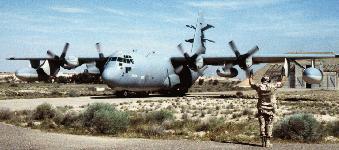
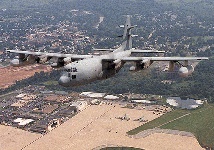
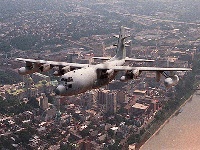
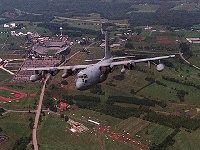
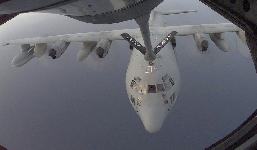
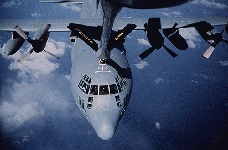

The EC-130H Compass Call is the only US wide-area offensive information warfare platform, Compass Call provides disruptive communications jamming and other unique capabilities to support the Joint Force Commander across the spectrum of conflict. Specifically, the modified aircraft uses noise jamming to prevent communication or degrade the transfer of information essential to command and control of weapon systems and other resources. It primarily supports tactical air operations but also can provide jamming support to ground force operations.
Modifications to the aircraft include an electronic countermeasures system (Rivet Fire), and air refueling capability and associated navigation and communications systems. The upgrade of the fleet to Block 30 is underway to improve system reliability and currency, however a two year funding gap exists between first squadron completion and second squadron start. This gap and other funding reductions have forced the SPO to stretch out Blk 30 completion to FY04, causing both fiscal inefficiencies and issues of technical obsolescence. Although some funding has been cut, limiting COMPASS CALL response to new threat systems, with the software reprogrammability of the new Block 30 aircraft, analysis and development of countermeasures to threats can be further leveraged by being more timely and effective. The Block 35 initiative will inject new technology required to improve reliability and increase COMPASS CALL's Offensive Counterinformation (OCI) capability against modern C2 systems. Major advantages are an update of receiver subsystem to satisfy current operational shortfalls and address immediate supportability problems. Procurement funding will subsequently modify/convert seven Block 30 COMPASS CALL aircraft to Block 40.During Operation Desert Storm EC-130H Compass Call electronic warfare aircraft, operating outside Iraqi airspace, safe from Iraqi defenses, jammed communications, hindering the effectiveness of Iraq's integrated air defense network. Rivet Fire has demonstrated its powerful effect on enemy command and control networks in Panama and Iraq.
Compass Call integrates into tactical air operation at any level. Although Compass Call primarily supports interdiction and offensive counter-air campaigns, the truly versatile and flexible nature of the aircraft and its crew enable the power of EC-130H to be brought to bear on virtually any combat situations.The EC-130H aircraft carries a combat crew of 13 people. Four members are responsible for aircraft flight and navigation, while nine members operate and maintain the Rivet Fire equipment. The mission crew consists of an electronic warfare officer, who is the mission crew commander (MCC), and experienced cryptologic linguist is the mission crew supervisor (MCS), six analysis operators and an airborne maintenance technician (AMT).
Aided by the automated system, the crew analyze the signal environment, designate targets and ensure the system is operating effectively. Targets can be designated before the mission takes off, acquired in flight or the MCC/MCS can receive additional tasking at any time from outside agencies (i.e. Airborne Warning and Control System, RC-135 and Airborne Command and Control System.) A radio frequency signal runs from the beginning of the received path through the system and is analyzed at different points along the way. In a war situation, a signal may be received and linguists on board the plane analyze it to determine if it is an enemy signal. If the system decides there is a threat, communications would be jammed by the officer on board pressing the red buttons. On the back of the plane is microwave powered equipment which sends out high energy radio frequency output or interference.
The latest technologies, referred to as the Block 30 system, update the fleet and keep the 41st Electronic Combat Squadron�s Combat Systems Flight busy ironing out the bugs. The flight�s 25 computer and electronic warfare troops perform organizational level maintenance on EC-130H weapons systems. Block 30 totally rearranges the equipment on the EC-130H and incorporates fiber optics. There are more fiber optic terminations on this plane than any other plane flying, commercial or military today. Block 30 improvements include faster and more powerful computers and integrated work stations which enable the fleet to accomplish its primary mission of denying enemy commanders the ability to command their troops in the battlefield. Unlike Block 20, which operates through a mainframe, Block 30 is broken down into different components which communicate with each other.
The conversion to the Block 30 system, designed by Lockheed and several other contractors, has been a time-consuming project. Each plane requires approximately 16 months for modification at the Lockheed Martin Skunk Works plant in Palmdale. Unlike other weapons systems which are tested before they are bought, Block 30 was purchased before being tested. All new hardware and a five-fold increase in the amount of software, which includes over one million lines of computer code, have produced the usual minor bugs that always seem to appear with new technology improvements. One common problem is the failure of a built-in self test. The main hardware issue has been getting spares. The spare issue is a problem of manufacturers not making the number of parts and components needed. Budget cuts and appropriations have caused some of this.Compass Call is tasked by all the unified commands and therefore subject to worldwide deployment in support of tactical air/ground forces on very short notice. The Compass Call EC-130H is flown by the 355th Wing's 41st and 43rd Electronic Combat Squadrons, at Davis-Monthan Air Force Base, Ariz. The COMPASS CALL fleet is comprised of 13 aircraft (10PAA/ 2BAI/ 1 attrition reserve) in two squadrons (41ECS and 43ECS).
